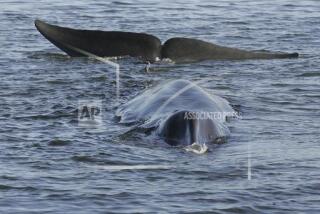Tourism in Azores Islands Zeros In on Whales
- Share via
MADALENA, Azores Islands — As tourists flock to marvel at the whales and dolphins off these mid-Atlantic islands, an environmental dispute is brewing that threatens to match the Azores’ stormy seas.
Ecologists and some tour operators say the recent boom in whale-watching is endangering the mammals because more and more boats are crowding around them.
The critics say local authorities, who regard whale-watching as an easy source of revenue for these largely undeveloped Portuguese islands, are handing out too many licenses to new companies looking to cash in on the bonanza.
The Nature Protection League, a Portuguese environmental group that has monitors in the Azores, says it is deeply concerned about reports of some tour boats engaging in “close-quarter pursuits” of whales and dolphins.
“The increase in the number of operators is a real problem because competition for business will certainly bring a push for even better service, meaning ever-closer observation of the whales, mostly by chasing them down,” says Maria Joao Pereira at the environmental group.
Jaime Chu, a partner in a whale-watching company on Pico, one of the archipelago’s nine islands, fears the worst.
“It’s going to be a chaotic turf war the way it’s going. One day we’ll have 50 boats around one whale,” Chu says gloomily, noting there are now more than a dozen operators on Pico, a small island of about 10,000 people.
Chu says his company sticks rigidly to the international whale-watching code of conduct. He is angered by what he calls the government’s scant policing of tour boats, which he claims allows some unscrupulous companies to flout the rules while at sea and out of sight of land. He declines to specify the companies.
About 25 species of whales and dolphins have been spotted off the Azores, traveling along the Gulf Stream. Rich in food, the sea provides breeding and calving grounds, making this a prime--and still relatively undiscovered--spot for whale- and dolphin-watching.
Whales and dolphins have highly sensitive hearing and become distressed when speedboats tear around them, gunning their engines.
Bothering the whales can alter their migration patterns, separate groups and interfere with the reproductive activity of the protected species, experts say.
Whale-watching is becoming big business on Pico, where most people live modestly from subsistence farming or fishing and average monthly earnings are below 100,000 escudos, or about $540.
A boat carrying 12 people on a three-hour trip out to sea can earn 100,000 escudos. And locals say some owners elicit cash payments of $325 to allow a customer to jump in and swim with whales--an exceptionally distressing activity for the mammals.
For 150 years, until 1984, whales were hunted with harpoons on rowboats out of Pico. About 50 whales were slaughtered each year, providing the island’s main source of income. Then the world’s nations adopted a moratorium on killing whales that is still largely in effect.
Locals now fear that a hoped-for economic revival based on tourists paying to observe the island’s former quarry could be ruined if the business expands out of control.
“We don’t want to destroy our livelihood,” says Antonio Domingos, a former Pico whale-hunter turned whale-spotter.
Local tourism officials insist they are reining in the thriving whale-watching trade. They point to new rules introduced this year that, among other things, require boats to stay at least 50 yards from whales.
Emanuel Verissimo, a local director of Portugal’s Institute for the Conservation of Nature, says officials have promised to limit the number of whale-watching permits.
But he also concedes it is hard to enforce the law, mainly because of the vastness of the sea.
“There are some new companies, and some of them are adventurers who are out to grab a piece of the market and have committed some irregularities,” he says, but he also insists that “it’s not a big problem.”
More to Read
Sign up for Essential California
The most important California stories and recommendations in your inbox every morning.
You may occasionally receive promotional content from the Los Angeles Times.










